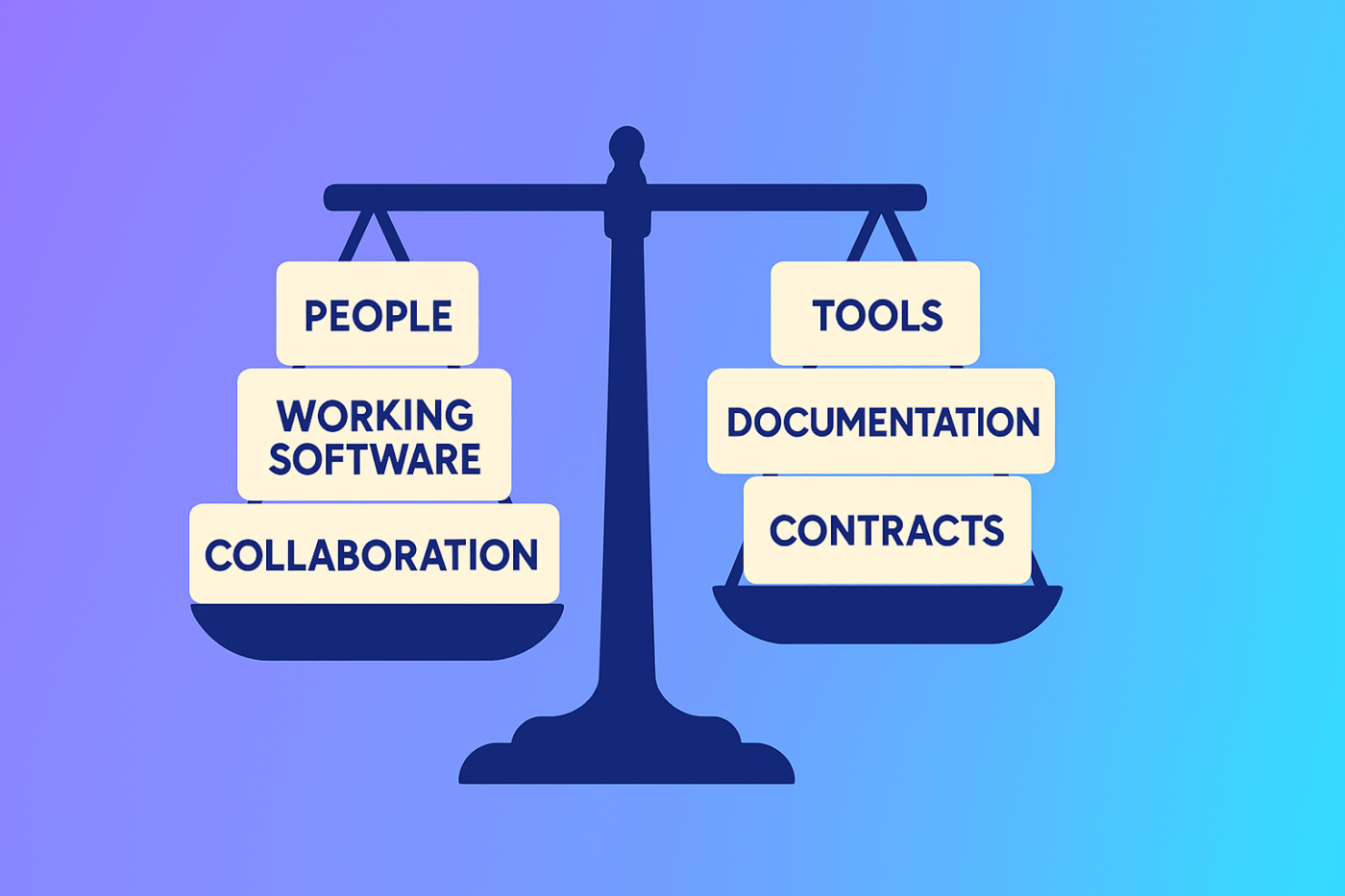What is Agile Project Management? Explanation & How To Start

Sorry, there were no results found for “”
Sorry, there were no results found for “”
Sorry, there were no results found for “”
Your team just spent six months building exactly what the client asked for. The demo goes perfectly. Then they say it: “This isn’t what we need anymore. The market shifted.”
I’ve watched this scenario destroy projects, budgets, and team morale more times than I can count.
The problem isn’t that requirements change. They always do. The problem is building processes that pretend they won’t.
Somewhere along the way, software teams realized something important: what if we stopped fighting change and started expecting it instead?
That shift in thinking became agile project management.
Agile project management is an iterative approach that delivers value through short work cycles called sprints, typically lasting two to four weeks, where teams plan, execute, review, and adapt continuously rather than following a rigid sequential plan.
Instead of spending months building everything before getting feedback, teams release working software every few weeks and adjust based on what they learn.
This directly solves the problem most teams face with long development cycles that deliver everything at once, only to discover the requirements changed months ago.
Traditional waterfall project management locks requirements at the start and moves through linear phases where each stage must complete before the next begins.
Customer involvement happens primarily during initial requirements gathering and final delivery, with nothing tangible in between.
Agile inverts this entirely. Customers engage throughout the project lifecycle, seeing working software every sprint.
Teams welcome requirement changes even late in development, treating them as competitive advantages rather than costly problems.
The methodology keeps focus on customer value within established time and cost constraints by making change the expectation rather than the exception.
Organizations achieving successful agile transformations report approximately 30% gains in efficiency, customer satisfaction, and employee engagement.
When they switched to two week sprints, they shipped their first working feature in four weeks and adjusted direction based on real customer feedback. That pivot saved the product line.
I watched a Fortune 500 client struggle for nine months with waterfall planning before realizing their market had shifted completely.
When they switched to two week sprints, they shipped their first working feature in four weeks and adjusted direction based on real customer feedback. That pivot saved the product line.
The Standish Group’s research reveals agile projects achieve 42% success rates compared to just 13% for waterfall projects. Meanwhile, waterfall projects fail 59% of the time versus only 11% for agile.
These aren’t small differences. They represent fundamental improvements in how teams handle uncertainty and deliver value when requirements evolve.
Looking for an easy way to manage your Agile team all in one place? Get ClickUp’s Agile Management Template for free here!
The Agile Manifesto established four values in 2001 that still guide modern teams. These aren’t abstract philosophy but practical priorities that shape daily decisions.
These values don’t mean abandoning processes, documentation, contracts, or plans entirely. They simply prioritize what delivers the most value when forced to choose.

Teams execute agile through repeating sprint cycles that transform ideas into working software.
Each sprint follows the same rhythm, typically lasting two weeks, creating predictability while maintaining flexibility within that structure.
The cycle kicks off with sprint planning, where the team selects which product backlog items they believe they can complete during the sprint.
But this isn’t just picking tasks randomly. The product owner explains what’s most valuable right now, and developers assess what’s feasible given their current capacity and past velocity.
Together, they define a sprint goal that gives the work meaning beyond just completing a checklist.
The team also breaks down selected items into smaller tasks and creates a plan for how the work gets done.
Every day during the sprint, the team holds a fifteen minute checkpoint to stay synchronized.
These aren’t status reports to a manager. Instead, they’re working sessions where developers inspect progress toward the sprint goal and identify obstacles blocking work.
Each person shares what they accomplished yesterday, what they’re tackling today, and anything preventing forward movement.
The strict time limit keeps things focused, and any detailed discussions happen afterward with only the relevant people.
Between the ceremonies, developers create working increments that meet the team’s definition of done, self managing their work and adapting plans daily based on what they learn.
The sprint goal stays fixed, but how the team achieves it can shift as they encounter technical challenges or discover better approaches.
No changes get made that would endanger the sprint goal, though scope may be clarified and renegotiated with the product owner as the team learns more.
At sprint’s end, the team demonstrates completed work to stakeholders in a working session rather than a formal presentation, allowing feedback to immediately shape the next priorities.
Stakeholders see functioning software they can actually test and provide reactions based on real experience rather than theoretical requirements.
The product backlog often gets adjusted right there based on what everyone learns from seeing the increment.
The final ceremony concludes each sprint by examining what went well, what problems emerged, and which improvements matter most for the next sprint.
The team inspects how the sprint went regarding individuals, interactions, processes, and tools.
They identify the most impactful changes to improve effectiveness and either implement them immediately or add them to the next sprint backlog.
This built in improvement mechanism prevents teams from repeating the same mistakes sprint after sprint.
This rhythm creates transparency where everyone sees the work, inspection where progress gets examined frequently, and adaptation where the process adjusts when inspection reveals issues.
Agile isn’t one methodology but a family of frameworks. Three dominate modern implementation, and choosing between them depends on the type of work your team handles and how predictably it arrives.

Scrum is the most popular framework at 63% adoption, and for good reason.
It provides structured roles including product owner, scrum master, and developers, along with prescribed ceremonies and clear artifacts that give teams a concrete starting point.
The time-boxed sprint structure creates rhythm and predictability while still allowing adaptation within each cycle.
This framework works best for complex product development with teams of 10 or fewer where evolving requirements benefit from adaptive planning.
If you’re building something new where customer needs shift as you learn more, Scrum’s iterative approach lets you adjust direction every few weeks rather than committing to a rigid long-term plan.
Kanban takes a different approach by emphasizing continuous flow rather than fixed iterations.
Teams visualize their work on boards and set work-in-progress limits that prevent overloading and context switching.
Work gets pulled through the system as capacity becomes available, creating smooth predictable flow.
This excels for production support, maintenance teams with unpredictable continuous work, and operations teams providing ongoing service delivery where work arrives constantly.
If your team handles support tickets, bug fixes, or infrastructure requests that can’t wait for the next sprint planning session, Kanban’s continuous model fits naturally.
XP focuses intensely on technical excellence through disciplined engineering practices. Pair programming puts two developers at one workstation for continuous code review.
Test-driven development writes failing tests before code. Continuous integration immediately tests code when added to catch problems fast.
This fits best when code quality is paramount, teams are small and can be co-located for effective pairing, and requirements change frequently.
XP provides the technical practices that keep codebases maintainable even as requirements shift, making it particularly valuable for long-lived products where technical debt becomes expensive.
Teams commonly blend frameworks to get the best of each approach.
Scrum plus XP represents the most popular hybrid, using Scrum for project management structure while XP ensures technical quality through disciplined engineering practices.
This combination gives you sprint-based planning and stakeholder engagement from Scrum alongside the code quality practices from XP that prevent technical debt from accumulating.
Agile thrives when certain conditions exist:
These scenarios share a common thread: uncertainty that benefits from iterative discovery rather than upfront planning.
The flip side matters just as much. Fixed requirements with no expected changes waste agile’s flexibility since you’re paying the overhead of adaptation without needing it.
Similarly, heavily regulated environments like pharmaceuticals create a different problem by requiring extensive documentation that agile’s lightweight approach doesn’t naturally provide.
Some projects also face constraints that make iteration impractical. Physical construction projects have strict dependencies where sequential approaches simply make more sense.
And when contracts include fixed-price structures with predetermined outcomes and strict penalties, they fundamentally conflict with agile’s embrace of evolving scope.
Before committing, three prerequisites determine viability:
If you answer no to any question, hybrid approaches that blend agile practices with traditional project structure often make more sense than forcing a methodology that doesn’t match your constraints.
Starting agile requires a deliberate path rather than attempting instant transformation. Here’s how to move from planning to your first successful sprint.
Before diving into the specifics, this video provides a solid foundation on what agile actually looks like in practice:
Before announcing an agile transformation, evaluate whether your environment can actually support it.
Look at your project type first and confirm it has evolving requirements and needs frequent feedback.
Then examine whether team members are willing to change how they work, or if you’ll be pushing against entrenched resistance.
Finally, make sure stakeholders and leadership understand they’ll need to participate actively throughout the process rather than just receiving status reports at the end.
If any of these elements are missing, address those gaps before moving forward.
Agile transformations fail far more often from lack of organizational support than from technical execution problems.
Once you’ve confirmed readiness, pick one framework and commit to it for at least three months.
Scrum provides structure that works well for product development teams, while Kanban suits continuous flow work like support and maintenance.
If technical quality is your primary concern, XP focuses on engineering practices like pair programming and test-driven development.
The key is mastering one approach completely before blending frameworks, because you need to understand why each element exists before you start customizing it to your situation.
With your framework selected, choose one project that matters to the business but won’t sink the company if it hits problems.
This gives you room to learn without catastrophic consequences.
Plan for two to three sprints (four to twelve weeks) as your evaluation period, keeping the team small at four to five people so coordination overhead doesn’t obscure whether agile itself is working.
Make sure they can dedicate full time to the pilot rather than splitting attention across multiple projects.
Your pilot needs three key roles functioning properly from day one.
The product owner must be empowered to make daily spending decisions without seeking approval up the chain, and they need to stay available to the team rather than disappearing for days at a time.
Your scrum master should facilitate the process and remove obstacles rather than managing people in the traditional sense.
Finally, assemble a cross-functional development team that has all the skills needed to complete work without external dependencies slowing them down.
These roles aren’t optional extras you can skip. They’re structural requirements for agile to function as designed.
Start sprint planning by having the product owner explain current priorities while the team selects work they believe they can complete.
Work together to define what “done” actually means for your team so everyone shares the same standard, then schedule all recurring ceremonies like daily standup, sprint review, and retrospective and protect that time from other meetings.
Then start building and expect the first sprint to feel awkward, because it always does. Teams typically need three to five sprints to find their rhythm and establish reliable velocity.
Immediate improvements in team communication appear within the first sprint. John Deere’s transformation showed 79% cycle time reduction within six months.
Medium-term gains reach 165% productivity increases. Long-term maturity at twelve to twenty-four months creates self-sustaining culture with maximum ROI.
Agile is a philosophy from the Agile Manifesto with values and principles. Scrum is one framework implementing agile with defined roles, events, and artifacts.
Think of agile as healthy living philosophy while Scrum is a specific diet and exercise plan.
Yes, often more effectively. The Scrum Guide recommends three minimum but smaller teams adapt well. They communicate constantly, eliminating formal standups.
Larger teams cost three to four times more with more defects. Maintain retrospectives and consider Kanban or XP practices.
It’s no secret that Agile project management is one of the world’s most popular project management methodologies.
It’s simple and quick to help your team breeze through your tasks and projects in no time!
Additionally, as it emphasizes the change in response to customer feedback, you can rest assured that you’ll be putting out a product that your customers love.
If you’re looking to adopt Agile project management methods, why not try a software like ClickUp?
It has everything you need to manage your projects and sprints effortlessly! Sign up for ClickUp’s forever free version today
© 2025 ClickUp